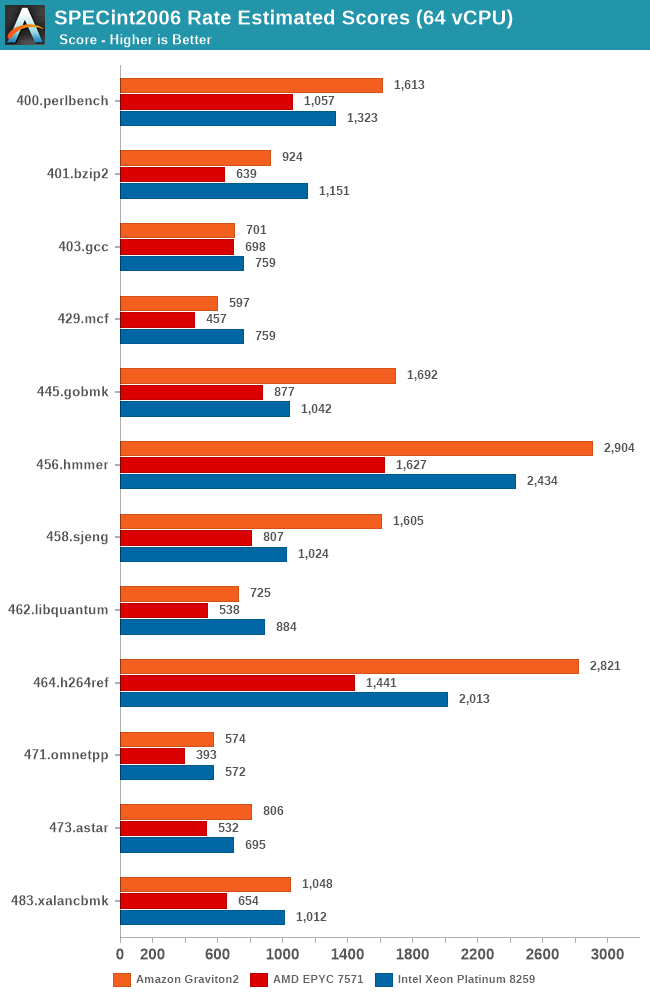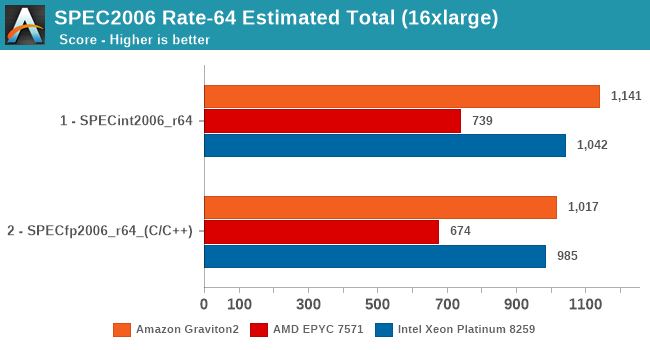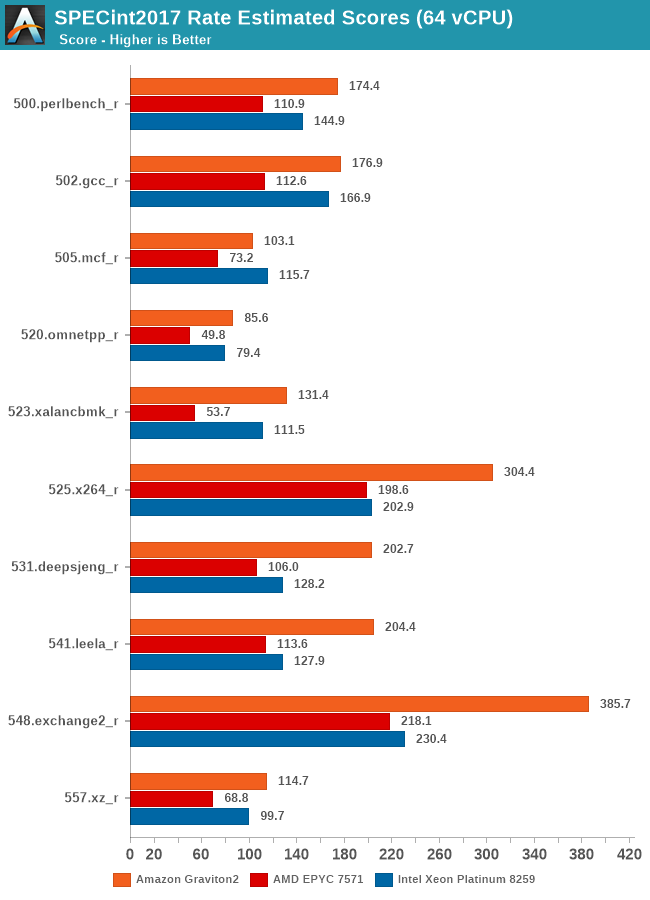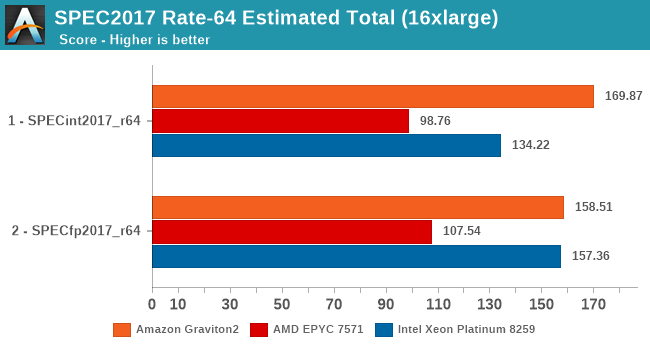Amazon's Arm-based Graviton2 Against AMD and Intel: Comparing Cloud Compute
by Andrei Frumusanu on March 10, 2020 8:30 AM EST- Posted in
- Servers
- CPUs
- Cloud Computing
- Amazon
- AWS
- Neoverse N1
- Graviton2
SPEC - MT Performance (16xlarge 64vCPU)
While the core scaling figures are interesting from an academical standpoint, what’s even more interesting is seeing the absolute throughput numbers compared to the competition. We’re starting off with SPECrate results with 64-rate runs, fully utilising the vCPUs of the EC2 16xlarge instances.
Again, there’s the conundrum of the apples-and-oranges comparison between the Graviton2’s 64 physical cores versus the 32 cores plus SMT setups of the AMD and Intel platforms, but again, that’s how Amazon is positioning these systems in terms of throughput capacity and instance pricing. You could argue that if you can parallelise your workload above a certain amount of threads, it doesn’t matter on whether you can achieve the higher throughput through more cores or through mechanisms such as SMT. Remember, when talking about silicon die area, you could at minimum probably fit 2 N1 cores in the same area than an AMD Zen core or an Intel core (probably an even higher number in the latter comparison).

The Graviton2’s performance is absolutely impressive across the board, beating the Intel Cascade Lake system by quite larger margins in a lot of the workloads. AMD’s Epyc system here doesn’t fare well at all and is showing its age.

It’s particularly in the non-memory bound workloads that the Graviton2 manages to position itself significantly ahead, and here the advantage of having a two-fold physical core lead with essentially double the execution resources shows its benefits.

In the overall SPECrate2006 results, the Graviton2 is shy of Arm’s projection of a 1300 score, but again the Amazon chip does clock in a bit lower and has less cache than what Arm had envisioned in their presentations a year ago.
Nevertheless, the Graviton2 has the performance lead here even against the Intel Cascade Lake based EC2 instances, which is quite surprising given the latter’s cost structure, and indicator of what to come later in the cost analysis.

Arm’s physical core count advantage here continues to show in the execution intensive workloads of SPECint2017, showcasing some very large performance leads in many workloads. The performance leap on important workloads such as 502.gcc again isn’t too great over the Intel system for example – Amazon and Arm definitely could do better here if the chip would have had more cache available.

In SPECfp2017, there’s more workloads in which the Xeon system’s 2-socket setup with a 50% memory channel advantage does show up, able to result in more available bandwidth and thus give the more memory intensive workloads in this suite a good performance advantage over the Graviton2 system. Still, the Arm chip fares very competitively and does put the older AMD EPYC processor in its place, and yes again, we have to remind ourselves that things would be quite different here if we’d be able to include Rome in our charts.

Overall, the Graviton2 system has an undisputed lead in the SPECint2017 suite, whilst just edging out on average the Xeon system in the FP suite, only losing out in situations where the Xeon’s higher memory bandwidth comes at play.










96 Comments
View All Comments
eastcoast_pete - Tuesday, March 10, 2020 - link
While I am currently not in the market for such cloud computing services aside from maybe some video processing, I for one welcome the arrival of a competitive non-x86 solution! Can only make life better and cheaper when and if I do. Also, ARM N1 arch lighting a fire under the x86 makers in their easy chairs will keep AMD and Intel on their feet, and that advance will filter down to my future desktops and laptops.eastcoast_pete - Tuesday, March 10, 2020 - link
Thanks Andrei! Just out of curiosity, that "noisy neighbor" behavior you saw on the Xeon? I know it's mostly speculation, but would you expect this if someone is running AVX512 on neighboring cores? AVX512 is very powerful if applications can make use of it, but things get very toasty fast. Care to speculate?willgart - Tuesday, March 10, 2020 - link
where are the real life benchmarks???video encoding / decoding ?
database performance ?
web performance ?
https encryption ?
etc...
The_Assimilator - Thursday, March 12, 2020 - link
Agreed 100%. Without figures of actual real-world applications compiled with actual real-world compilers handling actual real-world workloads, this essentially amounts to an advertorial for Amazon, Graviton2 and Arm.Danvelopment - Wednesday, March 11, 2020 - link
This may sound stupid as I'm just getting into AWS as backup throughput for local servers on my web project that releases April."If you’re an EC2 customer today, and unless you’re tied to x86 for whatever reason, you’d be stupid not to switch over to Graviton2 instances once they become available, as the cost savings will be significant."
How do you know whether what you're using is Intel, AMD or Graviton(1/2)? (I'm using T2s right now with no weighting and if our release gets hit hard, will give it weight and and increase its capacity).
As they're not actually doing anything, then I'd have no issue switching over, but can't tell what I'm on.
CampGareth - Wednesday, March 11, 2020 - link
There's a list here: https://aws.amazon.com/ec2/instance-types/If you're on T2 instances you're on Intel chips at the moment.
Quantumz0d - Wednesday, March 11, 2020 - link
No real benchmark. Another SPEC Whiteknighting. I see the AT forums Apple CPU thread being getting creamed over this again.ARM is a lockdown POS. You can't even buy them in this case. Altera CPU didn't even came to STH for comparision where it had so many cores against x86 parts. You cannot get them running majority of the consumer workload. One can claim Power from IBM has SMT8 and first Gen4 and all but if its not consumer centric it won't generate much of profit.
Author seems to love ARM for some reason and hate x86. Its been since Apple articles but in real time we saw how iPhone gets decimated in speed comparison against Android Flagships running the stone age Qualcomm. We have seen this ARM dethroning x86 numerous times and failed. I hope this also fails, a non standard CPU leaves all fun out of equation. And needs emulation for consumer use which slows down performance.
People want to see all the workloads. Not SPEC. Also where is EPYC Rome comparision Nowhere. Soon Milan is going to hit. Glad that AMD is alive. This stupid ARM BGA dumpster should be dead in its infancy.
Wilco1 - Wednesday, March 11, 2020 - link
LOL - someone feels extremely threatened by Arm servers...Mission accomplished!
anonomouse - Wednesday, March 11, 2020 - link
Well that was bizarrely incoherent. What workloads would you want to see instead? Nothing else you wrote made any sense or had any facts behind it.Andrei Frumusanu - Wednesday, March 11, 2020 - link
He's been doing it for the last year or two, ignore it.